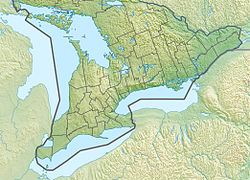| Jaffari Community Centre | |
|---|---|
 A chandelier inside the prayer hall | |
| Religion | |
| Affiliation | Shia Islam |
| Ecclesiastical or organisational status | Husayniyya |
| Ownership | Islamic Shia Ithna-Asheri Jamaat of Toronto |
| Leadership | Sayyid Muhammad Rizvi ('Ālim) |
| Status | Active |
| Location | |
| Location | 9000 Bathurst Street, Thornhill, Greater Toronto, Ontario |
| Country | Canada |
Location of in southern Ontario | |
| Geographic coordinates | 43°50′30″N79°27′39″W / 43.8417°N 79.4608°W |
| Specifications | |
| Capacity | 800 worshippers |
| Dome | One |
| Minaret | One |
| Website | |
| jaffari | |
| [1] | |
The Jaffari Community Centre (JCC) is a Shia Islamic husayniyya and community centre, located in the Thornhill district, in the Greater Toronto area of Ontario, Canada. In addition to the prayer hall, the centre contains a library, cafe, gym, several banquet halls, and school, and primarily serves as a mosque. [2]
